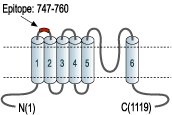Overview
- Peptide (C)NSTGIINETSDHSE, corresponding to amino acid residues 747-760 of human TRPA1 (Accession O75762). 1st extracellular loop.

TRPA1 (extracellular) Blocking Peptide (#BLP-CC037)
 Western blot analysis of rat brain lysate (lanes 1 and 3) and mouse brain lysate (lanes 2 and 4):1-2. Guinea Pig Anti-TRPA1 (extracellular) Antibody (#ACC-037-GP), (1:200).
Western blot analysis of rat brain lysate (lanes 1 and 3) and mouse brain lysate (lanes 2 and 4):1-2. Guinea Pig Anti-TRPA1 (extracellular) Antibody (#ACC-037-GP), (1:200).
3-4. Guinea Pig Anti-TRPA1 (extracellular) Antibody (#ACC-037-GP), preincubated with TRPA1 (extracellular) Blocking Peptide (#BLP-CC037)
 Expression of TRPA1 in mouse brainstem.Immunohistochemical staining of perfusion-fixed frozen mouse brain sections with Guinea Pig Anti-TRPA1 (extracellular) Antibody (#ACC-037-GP), (1:1000), followed by goat anti-guinea pig-Alexa-594. A. TRPA1 immunoreactivity (red) appears in the wall of the fourth cerebral ventricle (arrows). B. Pre-incubation of the antibody with TRPA1 (extracellular) Blocking Peptide (#BLP-CC037), suppressed staining. Cell nuclei are stained with DAPI (blue).
Expression of TRPA1 in mouse brainstem.Immunohistochemical staining of perfusion-fixed frozen mouse brain sections with Guinea Pig Anti-TRPA1 (extracellular) Antibody (#ACC-037-GP), (1:1000), followed by goat anti-guinea pig-Alexa-594. A. TRPA1 immunoreactivity (red) appears in the wall of the fourth cerebral ventricle (arrows). B. Pre-incubation of the antibody with TRPA1 (extracellular) Blocking Peptide (#BLP-CC037), suppressed staining. Cell nuclei are stained with DAPI (blue). Expression of TRPA1 in rat spinal cord.Immunohistochemical staining of perfusion-fixed frozen rat spinal cord sections with Guinea Pig Anti-TRPA1 (extracellular) Antibody (#ACC-037-GP), (1:1000), followed by goat anti-guinea pig-Alexa-594. A. TRPA1 immunoreactivity (red) appears in laminae 1-2 of the dorsal horn of the spinal cord (arrows). B. Pre-incubation of the antibody with TRPA1 (extracellular) Blocking Peptide (#BLP-CC037), suppressed staining. Cell nuclei are stained with DAPI (blue).
Expression of TRPA1 in rat spinal cord.Immunohistochemical staining of perfusion-fixed frozen rat spinal cord sections with Guinea Pig Anti-TRPA1 (extracellular) Antibody (#ACC-037-GP), (1:1000), followed by goat anti-guinea pig-Alexa-594. A. TRPA1 immunoreactivity (red) appears in laminae 1-2 of the dorsal horn of the spinal cord (arrows). B. Pre-incubation of the antibody with TRPA1 (extracellular) Blocking Peptide (#BLP-CC037), suppressed staining. Cell nuclei are stained with DAPI (blue).
- Hill, K. and Schaefer, M. (2007) J. Biol. Chem. 282, 7145.
- Story, G.M. et al. (2003) Cell 112, 819.
- Bandell, M. et al. (2004) Neuron 41, 849.
- Jordt, S.E. et al. (2004) Nature 427, 260.
- Zurborg, S. et al. (2007) Nat. Neurosci. 10, 277.
- Corey, D.P. et al. (2004) Nature 432, 723.
- Sotomayor, M. et al. (2005) Structure 13, 669.
- Clapham, D.E. (2002) Science 295, 2228.
The TRPA family is comprised of only one mammalian member, the TRPA1 (formerly named ANKTM1). TRPA1 is expressed in peripheral sensory neurons, where it is suggested to contribute to the detection of painful stimuli.1
Originally, it was thought that TRPA channels sensed painfully cold temperatures,2 but a more conservative description is that TRPA1 is sensitive to membrane/cytoskeletal perturbations caused by low temperatures3-5 and perhaps stretch.6 In addition, it is sensitive to pungent natural compounds present in cinnamon oil, mustard oil, and wintergreen oil.
TRPA1 is also expressed in hair cells, where its role in sensing mechanical forces is still unclear and controversial.1
TRPA1 has a similar structure to all other TRP ion channels; six transmembrane domains, intracellular N-and C-terminus. However, the N-terminal domain possesses 17 ankyrin repeats that might indicate its potential role as a mechanosensor.6,7
In addition, TRPA1 is expressed in nociceptive neurons expressing TRPV1 and might serve as a marker for polymodal nociceptors.8
Application key:
Species reactivity key:
Guinea Pig Anti-TRPA1 (extracellular) Antibody (#ACC-037-GP) is a highly specific antibody directed against an epitope of the human protein. The antibody can be used in western blot and immunohistochemistry applications. It has been designed to recognize TRPA1 from mouse, rat and human samples.
The antigen used to immunize guinea pigs is the same as Anti-TRPA1 (extracellular) Antibody (#ACC-037) raised in rabbit. Our line of guinea pig antibodies enables more flexibility with our products such as multiplex staining studies, immunoprecipitation and more.
